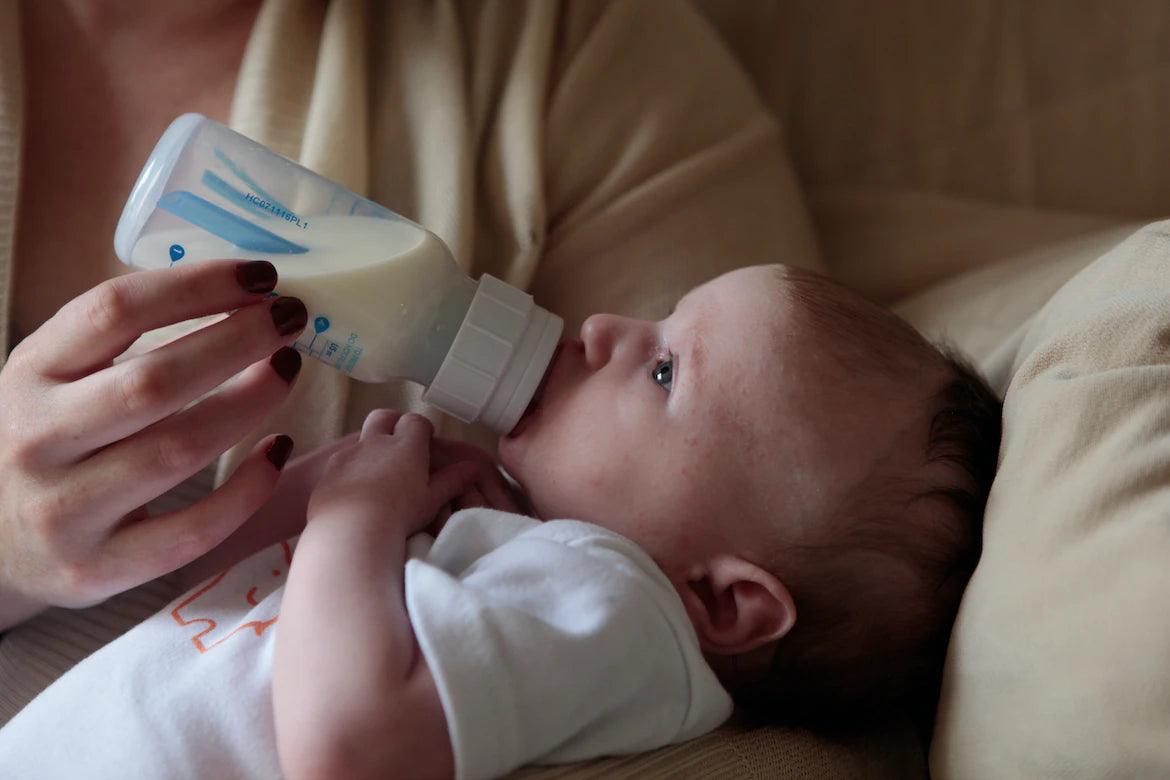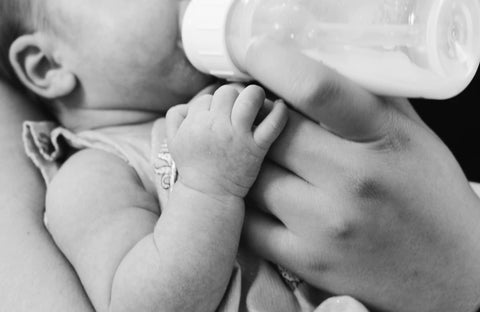Feeding Your Baby with a Baby Bottle
•Posted on December 19 2022

When you have a baby, a bottle is definitely indispensable. Whether it is mixed feeding, formula feeding, or breastfeeding bottle feeding, the healthy growth of the baby can not be separated from the bottle. The bottle is the baby's dinner guy, bottles and nipples are well chosen, the child can eat well, in order to grow up healthy, so it is important to choose the right bottle.
But there is a wide variety of bottles on the market, different materials, different sizes, different designs. So in the end which is suitable for children? Many parents are worried about the choice. When choosing a bottle, we need to choose according to the age of the child, the amount of milk sucked, the speed of sucking and the type of food. Note that the hole in the nipple is not the bigger the better, check the product logo, determine the type of material, and reject substandard products. If you want to know more about bottles and want to choose a suitable bottle for your baby, then keep reading.
Table of Content:
- How to choose the material of milk bottle
- How to choose the size of the bottle
- How to sterilize baby bottles
- When do babies hold their own bottle
How to choose the material of milk bottle
The bottle consists of a bottle and a nipple, and these two structures are made of different materials, and the combination is really dazzling. Different materials, the advantages and disadvantages of different, parents need to be based on the actual family situation, use scenarios, baby growth to buy.
Bottle
In accordance with the bottle body to distinguish the material, mainly divided into glass, plastic, silicone, stainless steel four.
| Advantages | Disadvantages | Replacement Frequency | Disinfection Situation | |
| Glasses | Good safety, high transparency, heat resistance, easy to clean and not easily scratched. | Not resistant to falling, fragile, heavy and not easy to carry, not easy to grip. | Replace in about 1 year, if cracks appear promptly. | High temperature/UV |
| Plastic | Lightweight and resistant, not fragile | Easy to accumulate milk scale, not easy to clean, and will have scratches after repeated cleaning. | 4-6 months to replace, during this period if there is a breakage, aging, oxidation and other phenomena, timely replacement. | Can be sterilized at high temperature, note the temperature upper limit. |
| Silicone | Soft touch, bionic breast milk, not easy to deformation, heat-resistant, anti-aging. | Easy to get dust, scale is generally not obvious, more expensive. | Change every three months | Can be sterilized at high temperature, pay attention to the upper temperature limit. |
| Stainless Steel | Easy to clean, drop resistant, can be insulated. | Unable to observe the internal condition of the bottle, heavier. | Replace in about 1 year | High temperature/UV |
Pacifier
In terms of material, there are two types of pacifiers: latex and silicone.
| Category | |
| Latex | Yellow in appearance, resilient and plastic; natural rubber odor, easy aging, poor heat resistance, poor corrosion resistance, some babies are allergic to latex. |
| Silicone | Colorless and transparent, soft and hard, no rubber odor, not easy to age, high transparency, heat resistant, corrosion resistant, no allergy risk |
How to choose the size of the bottle
Many new parents may be unaware that not only the bottles, but also the pacifiers have different specifications. After the actual purchase, we need to pay attention to check the instruction manual and use the product according to the shopping guide information.
Bottle (reference capacity)
In addition to the material, the purchase of milk bottles and the following major elements, need to pay extra attention to:
1. Light transmission: the bottle itself needs to have sufficient light transmission in order to facilitate the observation of the brewing of milk powder and the hygiene of the bottle.
2. Obvious marking: the scale of the bottle needs to be conspicuous enough to make it easy to see the scale when making night milk.
3. Accurate scale: newborns need to be fed several times a day, and inaccurate scales can lead to improper milk ratios.
4. Caliber: standard caliber bottles are easier to buy accessories, and wide caliber bottles are more convenient for brewing and cleaning.
Pacifier (model reference)
Regardless of the material or the baby's growth cycle, pacifiers are consumable and should preferably be replaced once a month. During use, if there is a breakage, discoloration, hardening or other conditions that affect the use, you also need to replace it in a timely manner. In addition, you need to pay attention to whether the pacifier has an anti-colic design when buying. After all, we are letting our babies drink their fill of milk, not eat air.
Pacifiers are divided into the following categories according to hole type and flow rate, which can be selected according to the baby's age and dietary needs.
Flow rate
| Model | Ages | Applicable |
| S | Newborn | Breastmilk and water |
| M | 2-3M | Formula milk |
| L | 6M | Formula milk, fruit and vegetable juices, etc. |
Hole type
| Shape | Ages | Applicable |
| Y-shape | 3M | Formula milk, fruit and vegetable juice and other complementary foods, multifunctional |
| Cross shape | 3M | Recipe milk, fruit and vegetable juice, rice flour, etc. |
| Linear shape | 6M | Formula milk, fruit and vegetable juice, rice flour and other coarse-grained beverages |
How to sterilize baby bottles
It is important to clean and disinfect bottles in a timely manner after each feeding of your baby. Bottles are difficult to clean in more places, easily accumulate milk stains, odors, simple brewing does not completely clean the bottle, you need to use the supporting tools for careful brushing.
The simplest method of disinfection is boiling, where all parts are disassembled and completely immersed in water and boiled. However, depending on the material of the bottle, the method and frequency of disinfection varies. Glass bottles are recommended to be sterilized daily, starting with cold water and continuing with boiling for 10 minutes. Plastic bottles are easily deformed and should be sterilized once a week, starting with boiling water and holding for about 5 minutes.
When do babies hold their own bottle
When babies first start to drink milk, it is usually the parents who hold the bottle for the baby to drink. When feeding, we have to stuff both the head and the narrow part of the neck of the pacifier in the baby's mouth, which can make sucking more comfortable. Normally, at 6 months of age, the baby's small muscles are mature enough to hold the bottle well. If your baby can't hold a bottle well by six or seven months, the main reason is that parents don't give your baby enough stimulation.
To train your baby to grasp the bottle by themselves, you have to get the timing right. If parents find that their baby wants to hold the bottle, it means the time has come to train your baby to learn to hold the bottle. Most babies like to grasp things when they are 4-5 months old, because babies at this stage are very curious about the outside world.
We can train your six-month-old baby to hold the bottle by himself through patient guidance: before your child drinks, you can show him the bottle, let him reach out and grasp it, and hold it through his baby's own will. At this time, the use of beautiful and colorful bottles to attract the child's attention can motivate the child.

How to wean baby off bottle
Long-term bottle use by babies to drink milk increases the risk of dental caries; the American Academy of Pediatrics recommends that babies stop using bottles at one week of age and need to be completely weaned at 18 months. Therefore, timing is important. For babies, the longer the habit lasts, the more difficult it is to break. You can try to reduce bottle use after the age of one, and try to do it when your baby is in good spirits, which can greatly improve the success rate. If your child is not feeling well, teething or is under psychological stress, it is not appropriate to let off the bottle.
The best way to transition from a bottle to a cup is to gradually reduce the frequency of bottle use and increase the frequency of cup use. In the beginning, we can use both a cup with a straw and a bottle, divide the milk between the bottle and the cup, and let the baby drink it all. When the baby is not yet proficient in using the cup, there will be less milk in the cup and more in the bottle, and when he becomes more proficient, there will be more in the cup and less in the bottle. After that, you can make clever adjustments to make the bottle "disappear" and the cup "go crazy" to enhance the effect. During this process, if your baby starts to cry, try using a soothing toy to distract your child.
The bottle is small, but it is a testimony to the growth of the baby. We, as parents, can only keep the bottom line of safety, the rest is up to the baby's preference. Keep trying, and you will eventually find the right one.
Comments
0 Comments
Leave a Comment